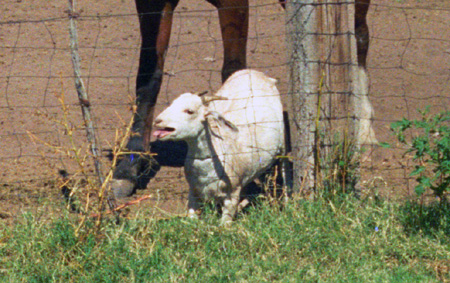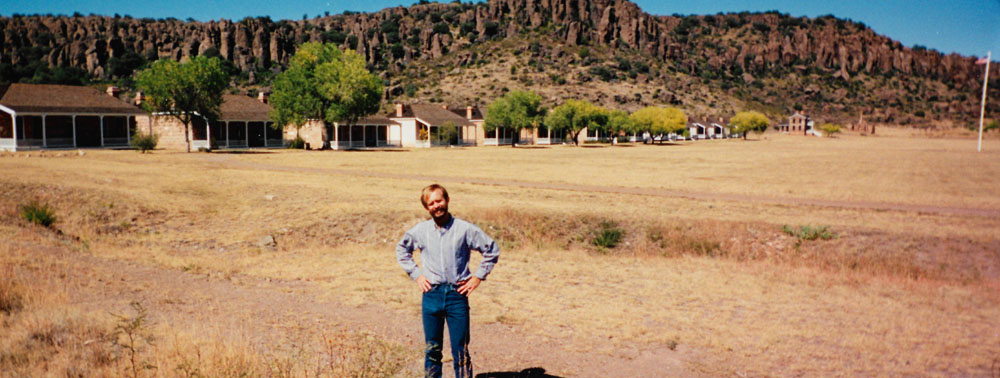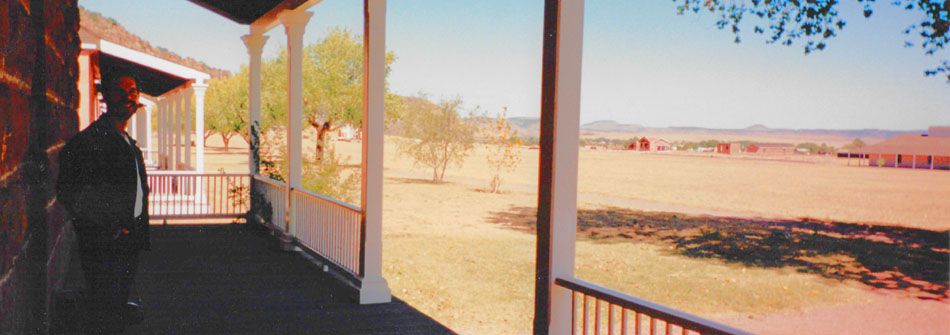

 |
October 22, 1993: The Window Trail and Boquillas Canyon |
 |
Return to the Index for Our Big Bend Trip |
We headed west on Wednesday evening, looking forward to meeting Frank and Joe at the Chisos Basin Campground tomorrow night. Fred had apparently tried to get Joe over to Big Bend before, but that was right at the time that Joe had first gotten sick, and he and Frank had canceled their trip. But this time, Joe was feeling fine, and so we expected that they would make it to the park.
Getting to Fort Davis, Texas
|
We stopped for dinner in Thurber, eating at a different restaurant from the time we stopped here in 1992.
We continued on and stayed on Wednesday night in Midland, Texas, at a nondescript motel just off the Interstate. On Thursday, we continued along Interstate 20 to Pecos, Texas, where we headed south on Texas Highway 17 through Saragosa. There was a lot of interesting scenery along the way; I am never bored on these trips. Texas Highway 17 continues across Interstate 10 to Fort Davis, Texas.
We planned to stop at the Fort Davis National Historic Site on our way down to Big Bend. I'd never been here before, so we were watching the signs as we came into Fort Davis from the north (along a very scenic highway, I might add).
|
 |
It was quite humorous the way the horse was trying to push it through, but with no luck; its horns were caught. After taking this picture, I got out and got the goat loose, and it immediately took off. Maybe it learned something.
The Fort Davis National Historic Site
|
Named for Secretary of War Jefferson Davis, the fort was first garrisoned by Lieutenant Colonel Washington Seawell and six companies of the Eighth U.S. Infantry. The post was located in a box canyon near Limpia Creek on the eastern side of the Davis Mountains- where wood, water, and grass were plentiful. From 1854 to 1861 , troops of the Eighth Infantry spent much of their time in the field pursuing Comanches, Kiowas, and Apaches.
With the outbreak of the Civil War and Texas's secession from the Union, the federal government evacuated Fort Davis. The fort was occupied by Confederate troops from the spring of 1861 until the summer of 1862, when Union forces again took possession. They quickly abandoned the post and Fort Davis lay deserted for the next five years.
The original post consisted of primitive structures. (It was located west of the present day Officers' Row, and a bit northwest from the site later occupied by the Post Hospital.) The foundations of several buildings from this earlier fort can still be seen today.
|
You are looking at the main parade ground, with the north end of Officers Row at left, and a group of two-story officer and Commanding Officer quarters to the north. There is also a church in this area; it was being restored during our visit.
The enlisted quarters and barracks are to my right and out of the picture. Incidentally, all of the Big Bend pictures were taken with my camera as Fred's is in the shop for repairs. Before we began our walk around the site, we stopped and had our lunch under some large cottonwood trees just southeast of the parking area. Fred, always the creature of habit, had eaten lunch at that exact spot the last time he had come to Big Bend. As I have said, Fred often does the same trip more than once, so long as he has somebody along who hasn't done the trip at all.
Not many of the fort's structures remained in June 1867, when Lieutenant Colonel Wesley Merritt and four companies of the recently-organized Ninth U.S. Cavalry reoccupied Fort Davis. The building of a new post, just east and south of the original site, began immediately. By the end of 1869, a number of officers' quarters, two enlisted men's barracks, a guardhouse, temporary hospital, and storehouses had been erected. Construction continued through the 1880s. By then, Fort Davis had become a major installation with more than 100 structures, and quarters for more than 400 soldiers.
|
Then we walked north to an area that I'll just call the "Commander's Area". Here, there were a group of two-story officers' quarters, and the separate house occupied by the Commanding General. In this picture, Fred is standing on the stairs of one of teh two-story officers' quarters- this one noted as being for married officers. This building has not been restored on the inside, so there is not much to see, but the outside has been repaired and painted.
Fort Davis's primary role of safeguarding the west Texas frontier against the Comanches and Apaches continued until 1881. Although the Comanches were defeated in the mid-1870s, the Apaches continued to make travel on the San Antonio-El Paso road dangerous. The scar left on the land by this road, the major route through the southwest going from East to West, can still be seen today. I have marked it on the aerial view above.
Soldiers from the post regularly patrolled the road and provided protection for wagon trains and mail coaches. The last major military campaign involving troops from Fort Davis occurred in 1880. In a series of engagements, units from Fort Davis and other posts, under the command of Colonel Benjamin Grierson, forced the Apaches and their leader Victorio into Mexico. There, Victorio and most of his followers were killed by Mexican soldiers.
With the end of the Indian Wars in west Texas, garrison life at Fort Davis became more routine. Soldiers occasionally escorted railroad survey parties, repaired roads and telegraph lines, and pursued bandits. In June 1891, as a result of the army's efforts to consolidate its frontier garrisons, Fort Davis was ordered abandoned, having "outlived its usefulness". Seventy years later, in 1961, the fort was authorized as a national historic site, a unit of the National Park Service.
|
|
Before we leave Fort Davis, I want to include a couple of pictures taken with Fred's panoramic camera. As I said, his regular camera was in for repairs, but since he had this one available he brought it along, and we'll see a number of pictures taken with it.
 Fred in the Parade Area East of Officers' Row |
 Looking Northeast from Officers' Row |
Fort Davis was immensely interesting, and I wish I could have spent a great deal more time in the museum attached to the Visitor Center. But we wanted to allow plenty of time to get down to Big Bend to meet up with Frank and Joe. So we stopped in the town of Fort Davis to stock up on some supplies (including my favored Diet Pepsi), and then we headed south on Texas Highway 118 to Big Bend.
Our Arrival and Campsite at Big Bend National Park
|
Anyway, it turns out that if you both enter and leave via Terlingua, you can probably get by without an entry fee, but if a Park Ranger notices that your car doesn't have a park pass on its windshield, I would presume you might be ticketed or something like that. In any event, we thought about going first to the Panther Junction visitor center to get our park pass, but instead we went directly to the campground in the Chisos Basin, intending to buy a park pass there at the Lodge that evening, or at Panther Junction the next day.
From our entry, we were actually heading east, and those are the Chisos Mountains off in the distance. The Chisos Mountains are the only mountain range contained entirely within a national park. The day had started out cool, but as we moved south and stayed at a low altitude, the weather got progressively warmer. We continued into the park towards Panther Junction, but before reaching it we turned south on the road into the Basin, where the campground, Chisos Mountain Lodge and other services are.
When we got there, we looked for Frank and Joe but didn't see them, so we thought we would go ahead and claim a campsite. The one we found wasn't too good, but we unloaded some stuff and I started preparing the site for the tent. Fred wanted to take one more thorough look around, and he returned shortly to tell me that he had found Frank and Joe and that they had already found a much better campsite. So we picked up the stuff we had left and headed down to meet them.
|
We went right to work to get things set up. The first thing we discovered was that the level area where the tent was supposed to go wasn't level and wasn't big enough for Fred's new tent. So we decided to set it up where the picnic table usually is, and move the table out from under the canopy. Setting up the tent was easy; lots easier than Fred's old one. It was a bit windy, so we put some heavy rocks around the ground covering to steady it. After our experience in Zion National Park earlier in the year, I had visions of it blowing down or away, but neither happened.
After the tent was set up, Fred began cooking dinner. Tonight's menu included stew, taco chips and sauce, and cookies. I suppose it is always true that food eaten out of doors always tastes good, no matter how simple it is. Fred doctors up just about everything he cooks, though, so it really doesn't taste as if it just came out of a can. It was getting progressively colder, and I, for one, was actually uncomfortable with just a T-shirt, shirt and jeans jacket. (And it was cold enough that having four people in the same tent turned out not to be a burden but rather a big benefit.)
While the cooking was going on, I was just trying to move around to keep warm, and so had the opportunity to take a few pictures. The view from our campsite was spectacular. You could see all the way down to the Window (more about that tomorrow), and you could see across the wide ravine to the Chisos Mountains on the opposite side.
|
|
Dinner is cooking, and I am still playing the role of paparazzi. If I were to go over and try to climb those mountains opposite, I would just walk up the sloping sections; I wouldn't attempt to climb any of the rock faces. Sadly, though, there wasn't time enough (or daylight enough) to have a go at them.
I took those couple of pictures and then wandered through the campground for a few minutes. I would say that about three-quarters of the campsites were taken, which I found a little surprising given that it was late in the year and that any families with kids would not be able to be here. I can only assume that in the summer it is hard to get a site unless you arrive very early in the day.
|
These peaks look as if you couldn't climb them, but there are areas where it should be possible for a careful person to get quite high, if not all the way to the top. One of these days, assuming that we don't end up hiking over there (Fred already has most of the hikes planned out), I would like to come back and try.
After we ate dinner, Fred planned for us to go to the ranger talk, but I confess that I was just too cold. I don't know why the cold was affecting me so- it probably wasn't much less than 35 or 40 degrees, but for some reason I was just shivering. I opted out of the talk, the first time that I haven't done something that Fred wanted to do. I just crawled into the tent and into the new sleep sack that Fred had bought, which turned out to be incredibly comfortable and warm.
When the guys got back, they were tired and cold, so all we did was hit the sack. I awoke about four in the morning for a short time, and got up to use the facilities up the road. Walking back to the tent I was impressed with how clear the sky was and how many stars I could see. I can tell a difference between being here at home and being in Van Alstyne as to the number of stars I could see, but here it was just fantastic. Nowadays, it is difficult for city folk to ever see the Milky Way, but here in the wilderness it stood out wonderfully.
I am looking forward to the hikes later this morning and this afternoon; they should be particularly enjoyable with Frank and Joe along to add new dimensions to the conversations that Fred and I usually have as we hike.
You can use the links below to continue to another page for our Big Bend trip or to return to the trip index so you can continue though the photo album.
 |
October 22, 1993: The Window Trail and Boquillas Canyon |
 |
Return to the Index for Our Big Bend Trip |